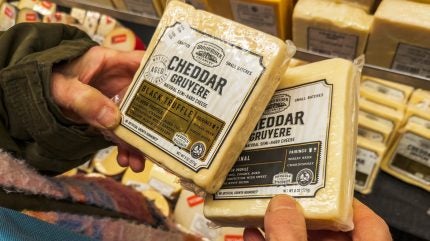 Cheese is driving the bus in the US dairy category due to growing demand, product innovation, promotions and a renewed focus by retailers.
Cheese is driving the bus in the US dairy category due to growing demand, product innovation, promotions and a renewed focus by retailers.
Cheese consumption in the US is at an all-time high of nearly 42lbs per person, according to US Department of Agriculture (USDA) data. For comparison, the average American consumed 32.2lbs of cheese in 2000 and 21.9lbs in 1980.
On the demand side, the International Dairy Deli Association (IDDA) estimates retail cheese sales will grow by an annual compound growth rate of around 4.5% between now and 2030.
Natural (cheese that isn’t processed), specialty (premium and higher-end cheeses) and private label (retailer-owned brands) are leading the sales growth charge.
According to data from industry research firm Circana, natural cheese enjoyed sales growth of 5% in 2023 and impressive unit sales growth of 1% (unit sales growth is difficult to achieve in times of high inflation).
Specialty products saw sales rise 3.1%, which is impressive because these items carry much higher retail prices, demonstrating that when it comes to certain categories US consumers have continued to indulge, albeit in a measured way.
Inflation accounted for a portion of the sales growth in these segments but, although it’s difficult to document quantitatively overall, brands have seen some unit sales growth.
In private label, natural cheese recently surpassed milk as the largest dairy category in terms of private-label dollar sales, reaching a whopping $9.5bn for the year to 28 January, according to Circana.
Dairy-focused industry trade groups like the California Milk Advisory Board and Dairy Farmers of Wisconsin (the states are the two largest dairy-producing states respectively in the US) are playing an increasing role in steering the growth and success of cheese in retail stores.
In addition to their private-label efforts, retailers, too, are having a positive impact, devoting more shelf space and off-shelf display space, particularly to natural and specialty products. Cheese has become one of the more creatively merchandised categories in US grocery stores in the post-pandemic world of food retailing.
Manufacturing growth, too
Increased consumption and growing demand are leading to a renaissance in the construction of new plants in the US. Numerous processors have opened new plants or have facilities under construction that are set to open this year or in 2025.
Industry experts tell me this is the largest growth in new cheese manufacturing facilities over a two- to three-year period that they’ve seen in their lifetimes.
California-based Hilmar Cheese Company is building a facility in Kansas. Colorado-based Leprino Foods, a mozzarella, whey protein and dairy ingredients manufacturer, is investing $870m to build a manufacturing plant in Texas. The new plant will produce more than one million lbs of cheese daily to be distributed throughout the US and internationally.
Ohio-based Great Lakes Cheese Company, a manufacturer and packager of natural and processed bulk, shredded and sliced products, is building a 500,000-square-foot facility in New York state.
From outside the US, Switzerland-based Emmi recently opened a new 158,000-square-foot plant in Wisconsin.
The US also is exporting more cheese than it ever has in its history. US exports have increased 688% since 2000, according to the US Dairy Export Council.
The opportunity for export growth is huge because the US is the leading global producer of cheese and has the largest supply of cow’s milk in the world. US exports are projected to be around 1bn lbs this year. Mexico, Korea, Japan, Canada, and Australia are the five top export countries for US-produced cheese.
But it’s here at home that matters most. The vast majority of the cheese produced in these new plants as well as in existing facilities serves the domestic market at retail and in foodservice.
Cottage cheese features in US retail growth
One of the major drivers of sales in the US retail channel has been the return of the prominence of food-at-home over food-away-from-home.
Before Covid-19, US consumers bought more of their meals out of the home than at home. This trend was hit by the pandemic and food-at-home has regained its supremacy.
Other key sales drivers for cheese at retail include social media, particularly TikTok, which has contributed mightily to both the popularity of charcuterie boards stacked with specialty cheeses and to cottage cheese. The latter saw dollar sales jump 16% to $1.33bn and unit sales rise 11% (for branded cottage cheese) in the year to 25 February.
Private-label cottage cheese sales have more than doubled over the same period, with dollar sales increasing by 13% and unit sales increasing by 7%.
Cheese is an “affordable indulgence.” Average consumers have had to cut back on spending across the board, including at the grocery store, over the last few years because of high inflation. However, people still want to treat themselves and cheese, like ice cream and candy, is an edible indulgence that is affordable and can bring joy.
There’s also been considerable innovation over the last few years, including in taste as well as variety. Natural cheese, both domestically made and imported, has caught on in the US like it did in Europe many years earlier and Americans are willing to pay a premium for quality. Often less is more, meaning that consumers will buy a quarter pound of specialty cheese at $29 dollar a pound, rather than 5lbs of processed cheese for $10.
Price-focused processed cheese remains popular though, which explains the growth in private-label. In large part, demand reflects the growing income disparities in the US.
But there’s even been a significant flight to quality when it comes to processed cheese, including private label, including retailers adding specialty products to their private label portfolios. Prices for private-label cheese, which today includes natural as well as processed SKUs, have increased but remain a bargain compared to many comparable national brands.
Dairy – cheese, milk, yogurt, eggs, butter and the like – is the most purchased category in US retail stores, with about 82% of consumers purchasing it during their typical shopping trip, according to data from Circana.
Cheese is the most dynamic and exciting category in US dairy and is generating the most investment in new and remodeled manufacturing facilities. Retailers and consumers seem to agree because they’re jumping on board.’
Source: Just Food



